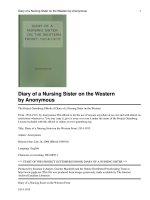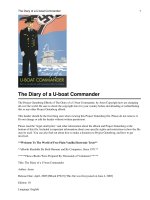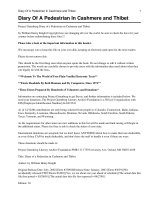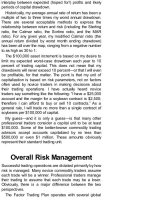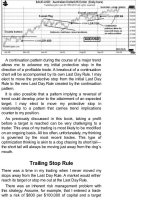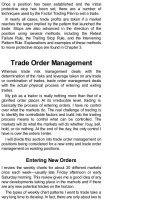Peter l brandt diary of a professional commodity trader lessons
Bạn đang xem bản rút gọn của tài liệu. Xem và tải ngay bản đầy đủ của tài liệu tại đây (12.39 MB, 359 trang )
Contents
Title Page
Copyright
Dedication
Acknowledgments
Part I: Foundations of
Successful Trading
Introduction
The Invention of a Commodity
Trader
Why I Wrote This Book
This Book’s Audience
The Book’s Road Map
Chapter 1: The History and Theory of
Classical Charting Principles
My Perspective of the Principles
Three Limitations of the Principles
Summary
Part II: Characteristics of a
Successful Trading Plan
Chapter 2: Building a Trading Plan
Trader Personality and
Temperament
Adequate Capitalization
Overall Risk Management
Points to Remember
Chapter 3: Identifying the Trades and
the Trading Vocabulary
Trade Identification
Vocabulary of the Factor Trading
Plan
Points to Remember
Chapter 4: Ideal Chart Patterns
Reversal H&S Pattern in Copper
Reversal Rising Wedge in AUD/USD
Continuation Wedge and Reversal
Failure Top in Soybean Oil
Reversal Triangle Bottom in Sugar
Continuation and Pyramid Patterns
in USD/CAD
Reversal Top in Silver
Continuation H&S Pattern in the
Russell 1000 Index
Continuation Rectangle in Kansas
City Wheat
Continuation Rectangle and Pyramid
Triangle in Crude Oil
Continuation H&S Top in the Dow
Utilities
Continuation Triangle, Reversal M
Top, and Flag in the EUR/USD
H&S Reversal Top and Three
Continuation Patterns in the
GBP/JPY
A Reversal Symmetrical Triangle in
the AUD/JPY
Two Continuation Patterns in
GBP/CHF
A Triangle and Running Wedge in
Sugar
An H&S Bottom in Apple Computer
A Major Continuation H&S and
Symmetrical Triangle in Gold
A Series of Bullish Patterns in
Copper
A Failed Ascending Triangle in the
USD/CAD Crossrate
A 12-Week Rectangle in the Dow
Jones Transport Index
A Rare Horn in Brent Sea Oil
An H&S Bottom Launches the 2009
Bull Market in the S&Ps
Summary
Points to Remember
Chapter 5: How the Factor Trading Plan
Works
Trade Identification
Trade Entry
Trade Risk Management
Trade Order Management
Points to Remember
Chapter 6: Three Case Studies Using
the Factor Trading Plan
A Remarkable Technical Event in the
Dow Jones
A Year Trading Gold
A Year Trading Sugar
Points to Remember
Chapter 7: Characteristics of a
Successful Trader
Intimate Knowledge of Trading
Signals
Discipline and Patience
Analysis of Self and of the Trading
Plan
It Takes a Leap of Faith
Points to Remember
Part III: A Five-month Trading
Diary: Let the Journey Begin
Chapter 8: Month One
Trading Record
Summary
Chapter 9: Month Two
Identifying Trading Opportunities
Amending the Plan
Trading Record
Summary
Chapter 10: Month Three
Sticking to the Plan in Choppy
Markets
Trading Record
Summary
Chapter 11: Month Four
Trading Record
Summary
Chapter 12: Month Five
Relying on Classical Charting
Principles
Trading Record
Outlook for the Future
Summary
Part IV: The Wrap-Up
Chapter 13: Analysis of Trading
Performance
How the Trading Plan Performed
How the Plan (and the Trader)
Evolved
Summary: Best Practices Going
Forward
Chapter 14: The Best Dressed List
A Seven-Month Double Bottom in
AUD/USD
A 14-Month Coil and Nine-Month
Descending Triangle in EUR/CHF
A Six-Month Wedge in EUR/USD
A 16-Week Horn in GBP/USD
A Four-Month H&S in Bottom
NZD/USD
A Six-Month Ascending Triangle
Failure in USD/CAD
An Eight-Month H&S Bottom in the
S&Ps
A 14-Month Symmetrical Triangle in
Sugar
A Seven-Month Triangle in Gold
A Series of Continuation Patterns in
Copper
An H&S Bottom in Crude Oil
Summary
Postscript
Final Performance
Performance Compared to Other
Benchmarks
Putting it in Perspective
Appendix A: Factor Trading Plan
Signals
Appendix B: Quick Reference to Charts
Appendix C: Recommended Resources
Author’s Note
Index
Copyright © 2011 by Peter Brandt. All rights reserved.
Published by John Wiley & Sons, Inc., Hoboken, New
Jersey.
Published simultaneously in Canada.
No part of this publication may be reproduced, stored in
a retrieval system, or transmitted in any form or by any
means, electronic, mechanical, photocopying, recording,
scanning, or otherwise, except as permitted under Section
107 or 108 of the 1976 United States Copyright Act,
without either the prior written permission of the Publisher,
or authorization through payment of the appropriate percopy fee to the Copyright Clearance Center, Inc., 222
Rosewood Drive, Danvers, MA 01923, (978) 750-8400, fax
(978) 646-8600, or on the Web at www.copyright.com.
Requests to the Publisher for permission should be
addressed to the Permissions Department, John Wiley &
Sons, Inc., 111 River Street, Hoboken, NJ 07030, (201)
748-6011, fax (201) 748-6008, or online at
www.wiley.com/go/permissions.
Limit of Liability/Disclaimer of Warranty: While the
publisher and author have used their best efforts in
preparing this book, they make no representations or
warranties with respect to the accuracy or completeness of
the contents of this book and specifically disclaim any
implied warranties of merchantability or fitness for a
particular purpose. No warranty may be created or
extended by sales representatives or written sales
materials. The advice and strategies contained herein may
not be suitable for your situation. You should consult with a
professional where appropriate. Neither the publisher nor
author shall be liable for any loss of profit or any other
commercial damages, including but not limited to special,
incidental, consequential, or other damages.
For general information on our other products and
services or for technical support, please contact our
Customer Care Department within the United States at
(800) 762-2974, outside the United States at (317) 5723993 or fax (317) 572-4002.
Wiley also publishes its books in a variety of electronic
formats. Some content that appears in print may not be
available in electronic books. For more information about
Wiley products, visit our web site at www.wiley.com.
ISBN 978-0-470-52145-8 (cloth); ISBN: 978-0-47094724-1 (ebk);
978-0-470-94725-8 (ebk); 978-0-470-94726-5 (ebk)
This book is dedicated to my wife, Mona, and my children,
who for more than 30 years have tolerated the ups and
downs of the life of a commodity trader.
Also to some very dear folks I refer to as the Factor family,
about two dozen fellow commodity traders who, since
1980, have served as a sounding board as I developed
my trading plan and honed my craft.
Acknowledgments
Iowe a debt of real gratitude to my friend Dave Forbes,
CEO of Petra Financial in Colorado Springs, who allowed
me to use his office and staff to prepare this book.
I am also in debt to Glen Larson and his awesome team
at Genesis Financial Technology, who provide me with
assistance in preparing the charts for this book. I use the
Genesis data and charting platform, TradeNavigator, in my
own trading and have found Glen and his team to be real
partners in my market operations.
Dan Chesler, President of Chesler Analytics (a firm
providing technical market research to energy traders)
originally suggested that I write this book. Dan and I go
back several decades as peers. If you have ever written a
book, you will understand it when I say that I don’t know
whether to thank Dan or curse at him for encouraging me.
Finally, I want to thank Meg Freeborn and Kevin
Commins of John Wiley & Sons for hanging with me during
this process. I started this book in early 2009, but for health
reasons I was sidetracked for nearly nine months. Meg and
Kevin demonstrated great patience and guidance to get
this project back on track.
Part I
Foundations of Successful
Trading
Is trading an art, or is it a science? Or is it some
combination of the two? I am not sure of the answers to
these questions. I am not sure it is necessary to know the
answers. I view trading as a craft. A successful trader is a
craftsman, applying his or her skills in the same way as a
baseball pitcher who has perfected throwing a knuckleball,
or a welder specializing in joining together exotic metals, or
a software engineer who overcomes complex problems to
design new chip technology.
All
craftsmen
undergo
apprenticeships.
An
apprenticeship is not some specified period of time in a
specified classroom or training grounds. Rather, an
apprenticeship is a composition of personal, professional,
and proprietary experiences that lead to the knowledge and
skills to perform a craft.
Part I of this book relates my apprenticeship as a trader
and provides context and background to all that follows in
the book. Part I contains two sections:
1. An Introduction to my background and history
as a trader, the reasons I decided to write this
book, a road map to the book, and what I hope
this book accomplishes
2. A brief overview of classical chart principles,
the foundation of my trading approach
Part I lays the foundation for the architectural design of
my trading plan, which is detailed in Part II.
Introduction
One of the first things I check out in a new book is the
number of pages prior to Chapter —long book
introductions put me to sleep. I will assume that most of you
are like me—you want to cut to the chase. The last thing I
wanted to do was write a book with a lengthy introduction,
but my opinion has changed now that I’m on the author’s
side of the equation. It turns out introductions can be useful
in providing necessary context and perspective for a book.
And so, please forgive me for committing the sin I have
always disliked—I think it will be worth it.
This is a book about me as a trader of commodity and
forex markets and how I use price charts in my craft. I think
of it as a mosaic: eventually the parts of this book will tie
together in the same way that a good mosaic becomes
visible only in its entirety. Piece by piece or section by
section, a mosaic makes no sense. Only at a distance and
in its fullness does a mosaic gain clarity and perspective.
The concept of a mosaic describes how this book will
unfold. First, a bit about how I got started in the business.
The Invention of a Commodity
Trader
In 1972, shortly after graduating from the University of
Minnesota with a degree in advertising, I moved to Chicago
to work for one of the nation’s largest ad agencies. A
neighbor was a trader at the Chicago Board of Trade
(CBOT). Through our conversations and my visits to see
him on the trading floor, I became captivated by the futures
markets. In commodity trading I saw the opportunity to earn
a good living, work for myself, and be challenged in a very
exciting field. In short, I became hooked.
Everybody started in the commodity field at the bottom.
Being hired at a sizable salary was not a reality of the
business. I needed a plan B if I were to quit advertising and
enter the commodity field. So, I asked the president of the
advertising agency if he would hire me back at a 30
percent increase in salary if I quit, tried the commodity
business for a year unsuccessfully, and reapplied for my old
job. He agreed to the deal.
I entered the commodity business in 1976 when I was in
my 20s with the singular goal of trading my own personal
account. But I needed to learn the ropes first.
When I entered the business, most traders at the CBOT
(as well as the Chicago Mercantile and the New York
commodity exchanges) started at or near the bottom of the
pecking order. The same thing exists to this day. An “MBA
fast track” has never really existed in the trading pits. The
learning curve is steep—the washout rate is high.
I learned the business by working for Continental Grain
Company and Conti, its futures market brokerage
operation. At the time Continental Grain was the second
largest grain exporter in the world next to Cargill.
Continental sold its grain merchandising business to Cargill
in 1999.
During my time in the advertising field I had been working
on the accounts of McDonald’s and Campbell’s Soup
Company. It became a very fortunate coincidence that both
companies were huge users of agricultural products.
Processors of agricultural commodities, such as
Campbell’s Soup, had become accustomed to decades of
oversupply conditions and stable commodity prices. But a
number of events in the early 1970s, including global crop
failures, led to massive bull markets in the price of
agricultural products and nearly every raw material. In a
matter of months the price of some commodity goods
doubled. Figures I.1 and I.2 show gold and wheat prices as
proxies for raw material prices.
FIGURE I.1 Spot Gold Prices, 1830–2009.
FIGURE I.2 Soft Wheat Prices, 1860–2009.
Food companies were not prepared for the price
explosions taking place. Top management and purchasing
executives of these companies were desperate for
solutions. Few food processors had any experience with
forward pricing in either the cash or futures markets.
This was the environment when I switched careers from
advertising to commodities.
Immediately upon joining Conti, I approached the
president of Campbell’s Soup Company with a proposal. I
thought perhaps the futures markets could be a way for
Campbell’s Soup to hedge its forward purchases.
I suggested that the company appoint a senior
purchasing executive to relocate to Chicago for a time to
determine if commodity contracts might be a beneficial
management and purchasing tool. I further proposed that
the designated purchasing executive and I would then
submit a formal proposal to top management—and the
proposal could just as likely nix as recommend the idea of
futures contracts.
In the end, we recommended that the corporation could
strategically use futures contracts in cocoa (Campbell’s
Soup owned Godiva Chocolate at the time), corn and
soybean meal (to grow chickens for its various frozen and
canned products), soybean oil, iced broilers (then actively
traded at the CBOT), live cattle and hogs (depending on
the price relationship between the cuts of meats used by
the company and the price of live animals on the hoof), and
the three major wheat contracts traded in the U.S.
(Campbell’s Soup made noodles by the ton and owned
Oroweat and Pepperidge Farms bakeries).
Campbell’s Soup saw the wisdom in the use of
commodity futures contracts. My consulting role with the
company covered my business overhead and my family’s
living expenses while I learned the futures business. Had I
begun trading for myself immediately, I would have likely
been forced rapidly back into advertising or another career
path.
After learning the ropes for a couple of years, I began
trading proprietary funds around 1980, starting with less
than $10,000. Initially, my personal trading was not
successful, although not disastrous. I tried just about every
approach I heard or read about. The traders around me at
the CBOT were making money, but I just couldn’t seem to
find a niche that worked.
Then a friend introduced me to the book Technical
Analysis of Stock Market Trends, written in the 1940s by
John Magee and Robert Edwards. The book was—and still
is—considered the bible of classical charting principles. I
consumed the book in a weekend and have never looked
back.
Chart trading offered me a unique combination of
benefits not available with the other approaches I had
attempted or considered, including:
An indication of market direction
A mechanism for timing
A logical point of trade entry
A means to determine risk
A realistic target for taking profits
The determination of a risk/reward relationship
I have been a chart trader ever since. More specifically, I
trade breakouts of classical chart formations such as head
and shoulders tops and bottoms, rectangles, channels,
triangles, and the like. I focus on weekly and daily chart
patterns that form over a period of four weeks to many
months. Even though my focus on charts is longer term, my
actual trading tends to be short term, with trades lasting
anywhere from a day or two (in the case of losses) to a
month or two.
Since 1981, my principle occupation has been trading
proprietary funds, although off and on through the 1980s I
sold trading research to other traders. In the late 1980s and
early 1990s I traded some hedge funds for a couple of big
money managers such as Commodities Corp. (since
bought by Goldman Sachs). A number of the best hedge
fund traders in the world have worked for Commodities
Corp. (I do not pretend to be in their league.)
As a result of market burnout and an interest in
nonmarket opportunities, in the early 1990s I began to
distance myself from day-to-day contact with the markets
and granted power of attorney over my own funds to
another trader. It was not a successful experiment. From
the mid-1990s through 2006 I pursued some personal nonprofit interests (social causes) and did little or no trading at
all. I started to employ my former trading plan again in
January 2007.
In 1990, I cowrote a book with a since-deceased friend,
Bruce Babcock, titled Trading Commodity Futures with
Classical Chart Patterns, discussing in very general terms
my approach to trading. That book sparked a desire to
someday write a book providing much more detail on my
trading operations. This book is the product of that desire.
My Proprietary Trading Record
For the active trading years of 1981–1995 (including four
years when I granted power of attorney to another trader)
and again starting in 2007, my average annual rate of
return for proprietary funds has been 68.1 percent (annual
Value Added Monthly Index [VAMI] method). I experienced
one losing year during the time I was the sole trader for my
proprietary funds (–4.7 percent in 1988). The numeric
average of my worst annual month-ending drawdowns has
been 15.4 percent. The performance capsule of my
proprietary trading is shown in Figure I.3. Please read the
disclaimers and discussion of my proprietary trading in the
Author’s Note at the end of the book. Past performance is
not necessarily indicative of future results.
FIGURE I.3 Factor LLC Proprietary Trading Record.
Why I Wrote This Book
In the business of commodity trading books, advisory
services, seminars, and computerized trading programs,
there is a lot of junk being peddled. There are numerous
books written each year about speculating in stocks and
commodities. Does the investment world really need
another book?
Given my low opinion of most trading and investment
books, it is ironic that I am even writing this book.
Specifically, I have had a general disdain for books
approaching technical trading on a hypothetical basis. In
contrast, I love the Market Wizards series by Jack
Schwager because it presents the human side of real-life
traders who use their ingenuity to make money by
outsmarting the markets. If you have never read these
books, then you have really missed out on some great
insight into market speculation. I also loved two books by
Michael Lewis, Liar’s Poker and The Big Short: Inside the
Doomsday Machine because both offer a real look at the
real lives of smart traders.
I accepted this book challenge because John Wiley &
Sons and I shared a vision for a book that would be a diary
of my real-time trading operations during the course of a
set time frame.
This book contains a combination of seven
characteristics that I believe are unique among commodity
trading books:
1. I am a real trader who trades real markets in
real time with real money. I am not an
academician or a person who relies on the sale of
books to pay my mortgage. I am not selling a
trading system or subscriptions to an advisory
web site. I am just a trader trying to make money
from the markets.
2. This book will catalog real-time trading signals
and endeavors, not some arbitrary set of
optimized rules form fit to last year’s charts. This
book will be a real-time diary of my trading on a
day-by-day, trade-by-trade, thought-by-thought,
mistake-by-mistake,
victory-by-victory,
and
emotion-by-emotion basis. I am stepping out in
faith that I will even be profitable during the next 21
weeks. But traders take risks.
3. This book will reveal trading as an upstream
swim against human emotions. Consistently
successful trading is a tough job. I make no
pretense to the opposite. If trading were easy,
everyone would be doing it for a living. Some
other authors can share the glory of their constant
successes. I will discuss the emotions involved to
take the next trade after eight straight losing
trades. Successful speculation can lead to hairgraying, sleep-losing, and dog-kicking emotions. I
hope to convey the same.
4. I will attempt to show that successful
speculation is mostly about managing risks. In
fact, good traders view themselves first and
foremost as risk managers. Just like “Texas HoldEm,” how one plays his or her cards is more
important than the cards themselves. Money
management has not been given the attention it
deserves.
5. I will attempt to kill a really sacred cow whose
death is long overdue—the idea that it is possible
to be right on 70 or 80 percent of one’s trades.
This cow really needs to die. Perhaps I can strike
a successful blow.
Novice traders spend 90 percent of their time and
money pursing methods to identify trades. In my
own experience, “Trade identification” is the least
important component of a consistently profitable
trading operation. In fact, the method by which a
trader identifies the markets to trade is of very
little importance. I make no contention that the
method I use is the best or is even above
average. More to the point, how I select trades just
does not matter at the end of the day. I believe
that novice traders who chase systems that claim
success on 80 percent of trades do so because
they don’t have the stomach for losing trades. But
a strong stomach for losers and a miniature pride
on the need for winners are necessary for
consistently profitable trading operations.
6. I have absolutely no desire in this book to show
how I can turn a small fortune into a large one.
Books that talk about turning $10,000 into a
million dollars may be good marketing, but let’s
get real! A person who can achieve this type of
performance would possess all of the world’s
currency within a decade. Do the math!
I am risk averse. My goal in 2010 is an 18 to 24
percent return. I would be in hog heaven if
commodity futures and forex markets could
perpetually provide for me an average two or so
percent monthly return—with a minimum amount
of capital volatility. I will leave it to other authors to
disclose their secrets to big fortunes. If you are
looking for a book on how to convert a small
account into a million dollars, this book is not for
you. If you want a book that details a
comprehensive process for speculation aimed at
exploiting an edge, then keep reading.
7. Charting has been good to me. I know it may
sound a lot nobler than it really is, but I would like
to share what I have learned over the years about
the craft of trading chart patterns. In hindsight, it is
easy to imagine how a market should have been
traded. But in real time the chickens come home
to roost. I believe that I can add to the body of
practical knowledge on chart trading. Perhaps I
can spare others the torment of the learning
process.
In the end, my goal is to display the actions and emotions
of a professional trader—and this involves a whole lot more
than a way to identify the next trade.
This Book’s Audience
I am writing this book to:
Professional commodity and forex traders
The general investment public (especially Baby
Boomers who are now concerned about their
retirement assets)
Novice commodity “wannabe” traders who have
never really gained traction in their trading
Professional Commodity/Forex Traders
You will not learn a single thing from this book, although if
you are a chartist, hopefully I can add something to your
body of knowledge. Nor should you be reading this book to
learn anything about my approach and niche. You are
successful because you know precisely what your own
game plan is. But you may get a kick out of some of the
anecdotes I share as I attempt to exploit my “edge” in the
markets. You understand that successful speculation is
primarily a human endeavor as we attempt to “swim
upstream” against our emotions.
My hat is off to you. You are absolutely the best traders in
the world. The global financial meltdown of 2007 and 2008
would have never taken place if professional commodity
traders were in charge things of things. As a group, you can
be proud that you did not contribute to the global economic
woes of recent years.
As professional commodity and forex traders, you have a
lot to be proud of. Table I.1 takes a look at the performance
of the top 20 professional futures and forex trading
operations during the past five years (measured by riskadjusted rates of return).
TABLE I.1 Performance of the Top 20 Commodity/Forex
Trading Operations from 2005 through 2009
Source: Managed Account Research Inc. web site.
Of the top 20 professional commodity-trading firms
during the past five years, 19 made money in 2008 as the
rest of the financial world lost billions in the global
meltdown. Of these top 20 firms, the average five-year
compounded rate of return (ROR) was 12.9 percent. Seven
did not have a single losing year in the past five years. The
average worst peak-to-valley losing spell was only –10.5
percent. The average worst year among the 20 firms was –
1.9 percent. Compare this to the roller-coaster ride called
the stock market.
I believe that there are four principal reasons why the
community of professional commodity traders is profitable
year in and year out:
1. Most commodity and forex traders started
trading with proprietary money. You were not just
handed a multimillion-dollar pool because you had
your MBA in finance or your PhD in quantum
physics. In fact, you are just as likely to be a
college dropout, a European history or theology
major, or a former air traffic controller.
2. You understand risk because you trade
leveraged markets. You know the high price to be
paid for being stubborn with a losing trade. You
know that small losses have a way of becoming
large losses, and large losses can sink a ship.
You would have never let a massive pile of
worthless mortgage paper dig too deeply into
your pockets.
3. You trade transparent markets that have instant
